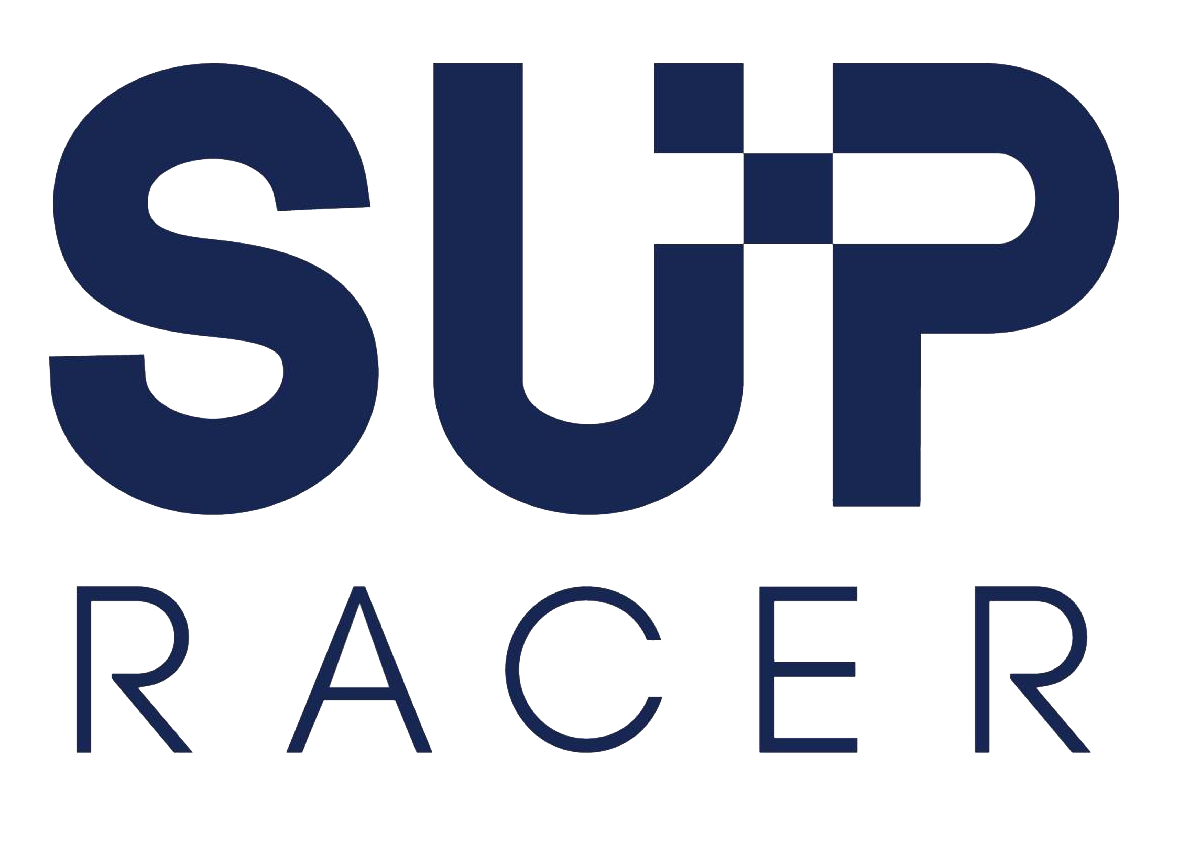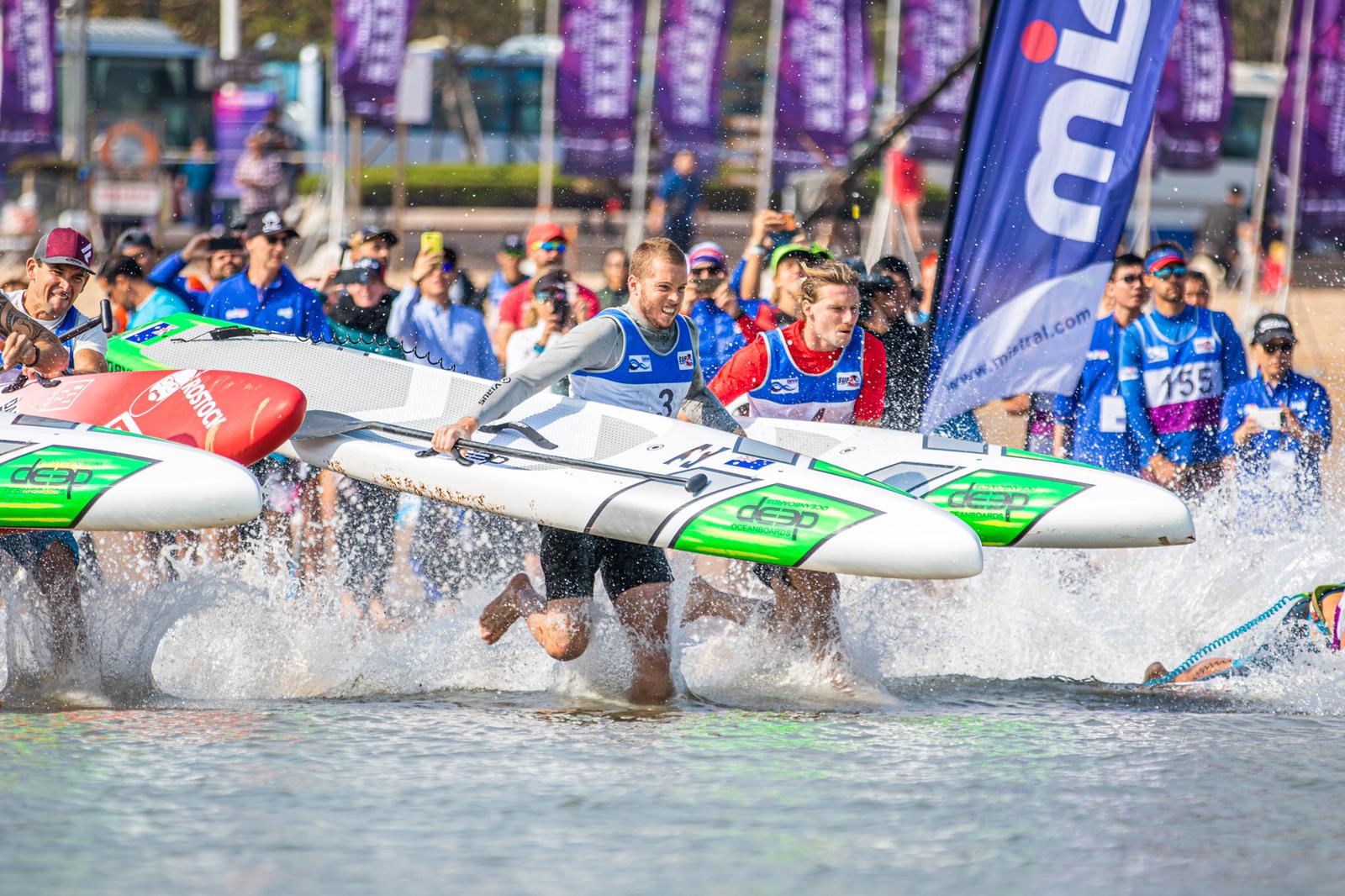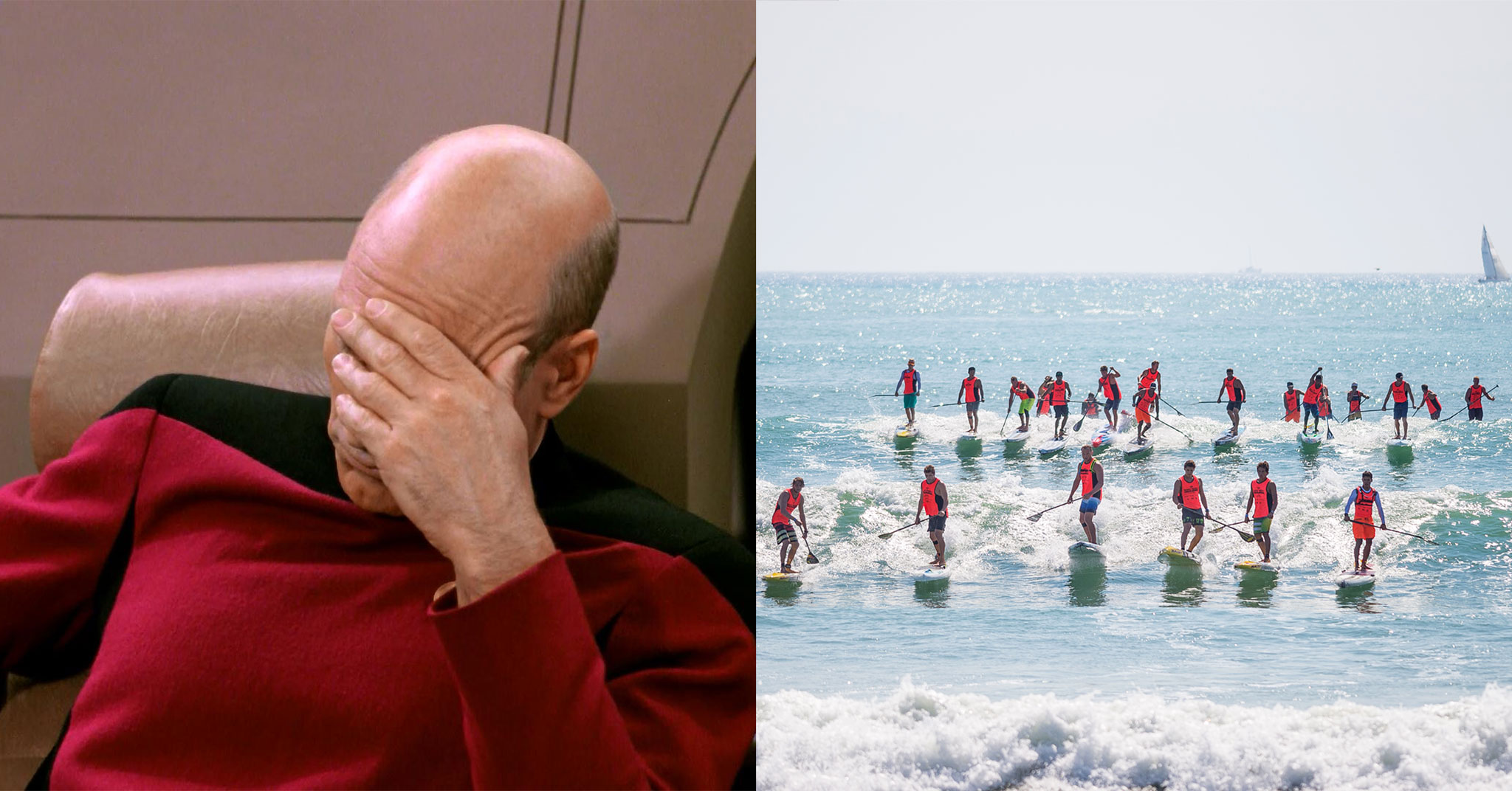
Facepalm: Pacific Paddle Games Flip Flops Back to 12’6, Adds Fuel to the Board Class Debate Just as the Fire Was Starting to Cool
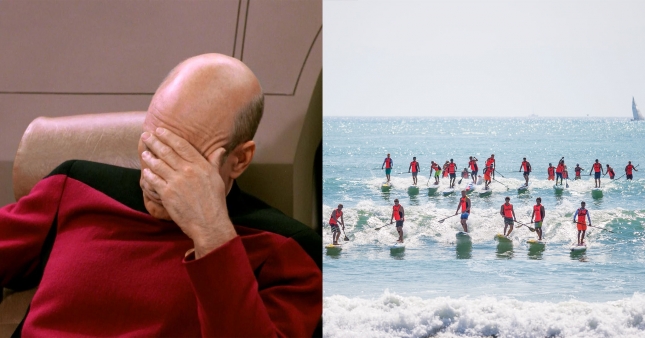
[notdevice] [/notdevice]
UPDATE Monday 13th June:
Pacific Paddle Games Organisers Listen, Reconsider, and Agree to Remain 14ft
Order has been restored.
Original story below…
Just when we thought the board class debate was finally reaching a logical, unifying conclusion, the Pacific Paddle Games has gone and poured some more kerosene on the fire.
After officially announcing the 2016 event last week, the PPGs crew confirmed another key piece of the puzzle today: They’re flip-flopping back to 12’6 boards for the men’s event (for both the surf race and long distance), after having led the way with a move to 14 footers last year.
While the 2016 PPGs will probably still be a great event, this decision is anything but.
It’s a decision that will not only fail to fix the target issue (reducing carnage), it will also cause confusion for the rest of the sport and hold the community back from reaching any real sense of unity right when it was on the verge of doing so.
It’s a decision that can only be described as facepalm.
But despite this, a logical solution is still within reach. Read on to find out what it is…
The ‘board class debate’ has been raging through the SUP community over the past half a decade like a wildfire, with some passionately supporting the 12’6 and others pushing for a 14′ standard. Opinion is split, with rival events, athletes and organisations all pushing their own egos and agendas.
The only thing that almost everyone can agree on is that having two separate board class standards is not only utterly ridiculous, it’s also hurting the growth of the sport.
Or in other words: Let’s just pick either the 12’6 or the 14 as the standard and move on.
Let’s bring an end to this trivial debate, and instead let’s focus our energy on far more important topics such as how to grow the grassroots, how to get more women and juniors competing, how to make the elite side of the sport more exciting and appealing to the masses, and so on.
Almost everyone agrees that having two rival board class standards is totally pointless because they’re so similar — we don’t need both of them when there’s only a foot and a half difference. If it was 10’6 and 16′ then perhaps you could justify having both, but 12’6 and 14′ are almost identical. Having one makes the other redundant.
Secondly, and more importantly, having two separate standards makes things far more difficult for consumers, brands, designers, team managers, distributors, retailers, event organisers, and the paddlers themselves; It makes it harder for everyone.
For years we’ve seen different events adopt a different standard, and it’s been messy to say the least. The absurdity of it all was highlighted perfectly in Europe a couple of years ago, when paddlers had to travel with both a 12’6 and a 14 footer to be able to compete each week, despite every race being held in the same conditions.
But while there’s always been an overwhelming consensus that we should choose either the 12’6 or 14, there’s never been much movement one way or the other in this seemingly-endless tug of war.
Until this year…
Anything up to 14′
Over the past six months, there’s been a huge shift in momentum towards having “Anything up to 14” as the standard board class worldwide. The important part is the anything up to, which provides the basis for a unified standard but still leaves flexibility for paddlers to make a choice.
And almost every big race around the world now uses “Anything up to 14” as standard.
Last year we saw the three major U.S. events using 14′ (at least for the guys): The Carolina Cup, the Gorge and the PPGs. Those were the three most competitive races in the world in 2015, and they helped drive the momentum towards a unified standard.
We’ve seen the exact same thing in Australia, where the three biggest events (Saucy Jack, The Doctor and the King of the Cut) have embraced the “Anything up to 14” standard, while you’d be hard pressed to even find a single 12’6 board in places like South Africa.
(Side note: North America is the *only* region that uses different board classes for different genders — in the U.S. it’s 14 for men and 12’6 for women at most big races. Every other nation uses gender-equal board classes. Nobody is really quite sure why America does this, but the general consensus is that both men and women deserve to be on the same boards.)
We’ve also seen the entire continent of Europe finally become unified behind the “Anything up to 14” standard. This summer in Europe, virtually every single event (with the exception of a couple of regionals) has set the board class at 14ft for both men and women, elite and amateur alike.
First it was the EuroTour doing an excellent job of setting the agenda, and now even the big SUP World Cup in Germany, which is affiliated with the ultimate 12’6 holdouts, the Waterman League, has switched to the 14 footer (which, by the way, was the original standard when the World Cup began way back in 2009) in order to attract more amateur participants and to make it easier for the traveling elite athletes.
The Waterman League was even talking to the athletes about adopting “Anything up to 14” as standard at all events in 2017, because they saw it as a logical step forward for both their own events and the sport in general. Meanwhile, the only other major 12’6 holdout still remaining, the ISA, has said that it too would seriously consider embracing the “Anything up to 14” standard at its annual World Championships if the trend continued at other big events.
In other words: We were finally on the verge of having some real unity in the sport.
So not only has the Pacific Paddle Games set itself back a couple of years, it’s set the entire sport back.
Not only is the PPGs the biggest race in the world, but this decision is going to encourage other big events like the ISA and World Series to continue with the status quo.
And the status quo sucks.
This isn’t about boards, this is about unity.
The sport of stand up paddle racing is woefully fragmented. There’s a serious lack of unity in the SUP racing world, and it’s causing real damage and holding us back from making real progress.
While a foot and a half of foam may seem trivial because it is trivial, it’s also hugely significant: The board class debate has come to symbolise the lack of unity in our sport, but I get the feeling that if all the major events could just agree on having one unified standard, it would be a huge leap forward.
And we were so close… Yet now, so far.
To be clear: This debate has nothing to do with which board is necessarily “better” (nobody will ever agree on that, and neither 12’6 nor 14 is a particularly logical or practical length — they’re both arbitrary numbers that were chosen years ago with little foresight, and if we started again from scratch we’d probably end up with a completely different standard length), it has everything to do with which board can help unify the sport of SUP racing, and right now it seems 14 is the only logical choice in that regard.
So why did the Pacific Paddle Games make a decision that will confuse the paddlers, the brands and the wider sport in general?
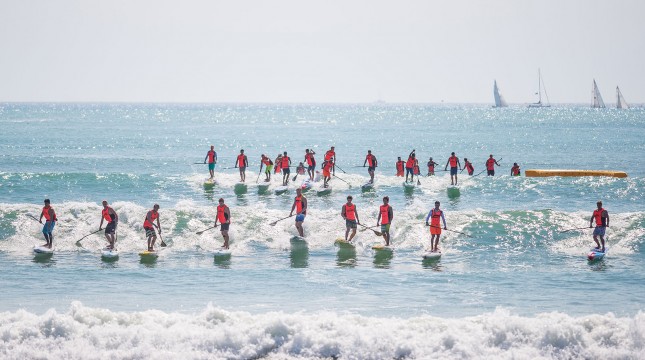
Pacific Paddle Games 2015: Everyone seems to be handling the waves just fine in this photo. That’s because it was mainly the large swell, low tide, bad placement of buoys and the size of the heats that were the problem, not necessarily the boards (photo: Welker/SUP Racer)
From the conversations I’ve had with the PPGs team – and to their credit, they actually do seek feedback before making a decision – even the organisers themselves were split on which way to go (which is rather symbolic of the entire sport), with some of the team wanting to maintain 14 and some wanting to go back to the old BOP Elite Race standard of 12’6.
In the end, the one single reason why they decided to flip-flop back to 12’6 is simple: They believed there was too much carnage during the surf race at last year’s Pacific Paddle Games, and that this carnage was dangerous.
And they’re absolutely right: There was.
At certain points, the men’s surf race descended into farcical chaos. Entertaining to watch, sure, but not a very good advertisement for our sport, and not particularly fair to the athletes. It was also dangerous, with at least one paddler requiring stitches after copping a board to the head.
However, all of this carnage had almost nothing to do with the length of boards and almost everything to do with the solid swell, the low tide, the number of paddlers in each heat, and the difficult course that had been set.
Moving back to 12’6 will not solve the “carnage” problem. Not at all.
I’m all for safety (the main reason the PPGs have given for this change), but 12’6 boards aren’t really any safer in the waves than 14 footers. This decision won’t make water safety any easier on its own.
Yes, 12’6 boards are easier to race in the surf than 14 footers. Just. They’re marginally easier, but they’re certainly not easy.
There’s this weird meme in the SUP racing world, where certain paddlers and event organisers cling to the belief that 12’6 is some magic, god-given number that works perfectly in the waves, whereas 14 is the devil’s work that doesn’t belong at all.
(To highlight this fact: While the vast majority of paddlers I’ve spoken with today have expressed deep disappointment with this decision, I know of several others who will come out and say it’s the right choice.)
Truth is, neither the 12’6 nor the 14 footer work very well in the surf.
If we want to focus on surf racing – and we should, because it’s the most exciting version of our sport – we should look at experimenting with boards in the 10’6 range, but more on this in a moment.
Even if the 2015 PPGs men’s surf race was on 12’6 boards, it would have looked just as chaotic and dangerous as it did on 14 footers. Maybe it would have been 1% or 2% safer, but it still would have been full of carnage. You only have to look at Salt Creek in 2014, or the older editions of the Battle of the Paddle at Doheny, to see how much chaos and carnage is caused by race boards in the waves regardless of their length.
14′ boards don’t belong in the waves. Nor do 12’6 boards.
Look at the photo below; This is what happens when you combine 14′ boards with waves. Ohhhh wait, those are actually 12’6 boards…
The photo below pretty much sums up why today’s decision from the Pacific Paddle Games team makes absolutely no sense.
This is from the 2013 Battle of the Paddle at Doheny (the exact same location as the PPGs). This was the Elite Race (i.e. the paddlers that know what they’re doing). And in 2013, the surf was much smaller and the course much safer and easier than it was for the PPGs last year. However, despite the 12’6 boards being used, the end result in 2013 was still the same as it was in 2015: Carnage. Lots and lots of carnage.
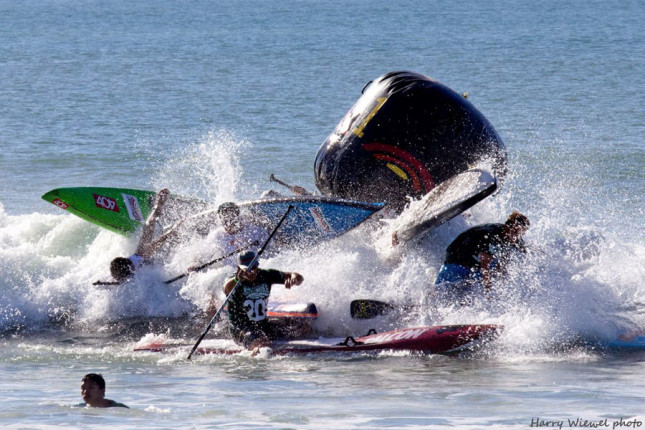
This is what happens when you combine 14′ boards with waves… Oh wait, these are actually 12’6 boards. (photo: Harry Wiewel via Facebook)
This photo highlights the fact that moving to 12’6 won’t magically solve the carnage problem. It doesn’t make the race any safer in any way. There’s still going to be just as much carnage no matter whether we’re riding 14, 12’6, 10’6 or 17 footers, and a knock to the head from a 12’6 carbon board will hurt just as much as a 14 footer.
The only thing that this flip-flopping decision from the PPGs team does is confuse the rest of the sport and hold the community back from achieving any real sense of unity.
All that the PPGs organisers had to do was set a more practical course this year, and also reduce the number of paddlers in each heat to reinforce the safety aspect. Those two little tweaks alone would have made things a lot less chaotic, a lot safer, and a lot more manageable for the water safety crew (again, last year would have been just as chaotic on 12’6 boards).
And you know what? That’s actually exactly what they’re doing: The Pacific Paddle Games organisers are changing both the size of the heats and the course this year.
The PPGs team conceded immediately after last year’s race that the course was wrong; That devilish little orange salmon buoy (where all the “carnage shots” were taken) was positioned in a bad location, pushing paddlers into an impossible-to-avoid head on collision that was just plain dangerous, before forcing them to turn their boards on a dime around a tiny little buoy, all while they were in the middle of the surf break during a solid south swell.
This year, the course will be more practical (i.e. safer and easier). It will still be a “challenging” course that tests the skill and strategy of the world’s best paddlers, but it won’t be as difficult (or as dangerous) as it was in 2015.
The PPGs team have also decided to drop the number of paddlers-per-heat from 32 down to 16 this year. That keeps the excitement of a big group of paddlers (having only 6 or 8 guys per heat is even less chaotic, but also kinda boring), while ensuring it won’t be total chaos like last year.
These two simple tweaks – less paddlers per heat and a more logical course design – will largely solve the problem of excess carnage and make the whole event safer without changing anything else; There was absolutely no need to flip-flop on the board class and plunge the rest of the sport back into a confusing, messy, unhealthy debate that was so close to being resolved.
It’s time for 12’6 to be phased out as an official board class. With all the momentum moving towards 14, there really is no logical reason to keep the 12’6. The vast majority of races around the world already use “Anything up to 14” as the standard for both men and women, elite and amateurs alike, so let’s continue that trend and finally get some unity in the sport.
The old ‘airline argument,’ which argued 12’6 boards are easier to travel with, has long been debunked, with no single airline differentiating between a 12’6 and a 14 (the vast majority of airlines want nothing to do with either, so if we’re really basing our sport around airlines, let’s all paddle inflatables and be done with it).
The only argument in favour of 12’6 that anybody still paid any attention to was that 12’6 boards handle better in the surf. And they do. Just. But as I’ve explained above: Neither the 12’6 nor the 14 footer are a practical solution for surf racing.
But even if you believed 12’6 boards really were significantly superior to 14 footers in the surf (they’re not), there would still be the counter argument of why should the distance race (which is 95% flat water at the PPGs) have to drop down to 12’6?
The simple fact is, “Anything up to 14” is a far more logical standard no matter which way you look at it.
Focus on the format, not the boards.
We definitely should be focusing more on surf racing. It’s the most exciting version of our sport, and we need to make our sport more exciting and appealing to the masses. We need more mainstream fans and sponsorship dollars if we’re ever going to grow beyond a tiny little niche sport, and the general consensus is that surf racing is our golden ticket.
So I’d actually prefer the PPGs completely drop the distance race and focus on the excitement of the surf race — and most of the top paddlers agree with me here.
For starters, it’s not fair to the specialist paddlers to do a “combined results” event based on two totally different types of racing. The counter argument is that this ‘combined’ event produces the best all-round paddler, however the problem is the “distance” race at the PPGs isn’t actually a distance race; it’s a 40 minute flat water draft train with a 200 metre sprint at the end.
(And besides, if you really wanted to claim you were producing the best all-round paddler, you’d have to include a downwinder, a river race, a marathon, flat water sprints, etc.)
What’s more, the PPGs distance race is boring. The spectators can’t watch it because paddlers disappear into the distance, while the webcast commentators are basically repeating the order of a 30-man draft train for half an hour before the one single minute of excitement at the finish. And for the paddlers, there’s not much skill involved when you’ve just gotta sit in a draft train for a few miles and then wait for your chance to sprint at the end.
Leave the distance races to the real distance events — the grand epics such as the Carolina Cup and the Lost Mills. Those events know how to do distance. The PPGs is the showcase event for our sport; It should embrace its strengths, and its overwhelming strength is the excitement of the surf race.
Our sport needs more excitement, and there’s nothing more exciting than surf racing. So whenever a surf race is involved, that should be the main focus of the entire event. Don’t water it down with a diet distance race. Of course you still want to have the open races for the weekend warriors and the grom races for the juniors, but make the elite showdown a surf racing-only affair.
If the PPGs focused on the surf racing, they could make the rule “Anything up to 14” and then it would be up to the paddlers to decide what they race, just like last year.
Hell, go one step further, make it an open board class and then you’d really be giving the athletes some freedom. When it comes to surf racing, you can let the conditions dictate the board class without worrying about an arms race (because unlike flat water races, nobody is going to race a 17 footer in and out through the surf).
Surf racing doesn’t really require a board length restriction at all, and indeed, I know of at least one major event that’s going to announce something very similar to this idea next week, after a couple of very wise athletes came up with the suggestion recently.
Make the elite race at the PPGs a specialty event, just like Huntington, Payette and Molokai are all specialty events that let the conditions dictate the board length (at the Payette River Games last year, for example, you would have been slower on a carbon 14′ than an inflatable 11 footer). This allows freedom of choice for paddlers, while also allowing designers and board brands to experiment. It also allows the unlimited class to retain its place in the grand open ocean races of Hawaii (and perhaps as an occasional R&D experiment in the flat water races).
And because these specialty events are just that, specialty races that cater to only a small handful of elite athletes, they won’t impact the general board market. Even if we start seeing more 10’6 custom race boards being used at places like Huntington, it’s not going to impact the wider industry; We’ll still have 99% of events and 99% of consumers using 14′ boards.
A logical conclusion to the board class debate.
I believe the logical conclusion to this whole saga is to embrace the “Anything up to 14” standard at the vast majority of races around the world. This gives the sport a unified standard and provides uniformity at 99% of ‘regular events’ around the world, while also allowing some flexibility if paddlers really prefer something shorter.
Then for the ‘specialty events’ (again: Payette, Huntington and Molokai are perfect examples), let’s embrace an “Open board class” exception where the conditions dictate the optimal length for each paddler.
For the next big surf race, some paddlers might choose 14, some may prefer 12’6, while some will probably experiment with 10 footers; I’d love to see someone like Mo Freitas rock up at Huntington and win on a 10’6, just to show what’s possible.
(For example at the surf life saving events, which are massive showcases in Australia, you see big tall guys that often weigh up to 100kgs – 220 pounds – charging in and out through the surf on the standard 10’6 prone boards, and nobody is saying those boards are too short; When it comes to surf racing, it’s not about length, it’s about volume.)
Remember, this isn’t about which board is better – the podium at the PPGs will probably look identical regardless of whether everyone is on 10’6, 12’6 or 14 footers – this is about unifying the sport.
Over the years, there’s been nothing more symbolically divisive in the world of stand up paddling than the trivial saga of the board class debate. C’mon, we’re debating a foot and a half of foam here. It’s ridiculous. Let’s just pick one already and be done with it.
I can’t believe we’re even still discussing this — we should have moved on from this debate years ago. These days, we should instead be focusing our energy on far more important topics such as growing the grassroots foundations of the sport, attracting more women and juniors, getting more mainstream fans and sponsors for the elite side of the sport, etc.
But now that we are back at square one (thanks a lot, PPGs), who should decide where the debate goes from here? Who can possibly resolve it?
Unfortunately, with no authoritative governing body (the ISA tries hard, but it’s still miles away) or legitimate world tour (the World Series tries even harder, but it’s even further away), who should actually decide?
Some say the paddlers need to get together and voice their collective opinion. And on many issues within the sport, they certainly should. But maybe not when it comes to equipment rules; Athletes generally have extreme opinions on either end of the spectrum, while they’re also full of unconscious bias. The athletes should have a strong say in this matter, but perhaps they shouldn’t have the final say.
Plus, from having spoken to almost every single elite paddler in the world over the past six months, I can confidently say we’re never going to get a consensus on board classes from within this group. (To highlight: I did a quick straw poll about today’s PPGs flip flop, and I can tell you that for every two or three elite paddlers who says it’s a disastrous decision, there’s one that strongly supports it.)
So if not the paddlers, who?
While the athletes can help unify many areas of the sport, I believe the only real hope for unity with board classes is for the major event organisers to all agree on a common standard. With the EuroTour and most of the big standalone races around the world embracing 14, all we really needed was for the ISA and World Series to come around. And both of them were on the verge of doing so.
Until today, it felt like we were all on the verge of accepting “Anything up to 14” and finally gaining some real unity in the sport, so that we could all move forward and focus on far more important matters.
Until today…
*facepalm*
The 2016 Pacific Paddle Games will still be a great event. It’ll still have a record prize purse, a world class webcast, and a fantastic event setup, while it’ll probably still attract the most competitive field of talent of any race all season.
But the 2016 Pacific Paddle Games also had a real opportunity to finally unify the sport once and for all. And on that point, the PPGs has failed.
